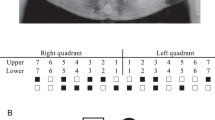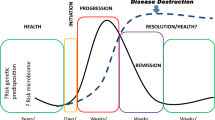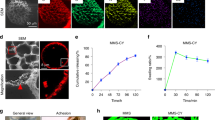Abstract
Cathepsin C (CatC) is a cysteine protease involved in a variety of immune and inflammatory pathways such as activation of cytotoxicity of various immune cells. Homozygous or compound heterozygous variants in the CatC coding gene CTSC cause different conditions that have in common severe periodontitis. Periodontitis may occur as part of Papillon–Lefèvre syndrome (PLS; OMIM#245000) or Haim–Munk syndrome (HMS; OMIM#245010), or may present as an isolated finding named aggressive periodontitis (AP1; OMIM#170650). AP1 generally affects young children and results in destruction of the periodontal support of the primary dentition. In the present study we report exome sequencing of a three generation consanguineous Turkish family with a recessive form of early-onset AP1. We identified a novel homozygous missense variant in exon 2 of CTSC (NM_148170, c.G302C, p.Trp101Ser) predicted to disrupt protein structure and to be disease causing. This is the first described CTSC variant specific to the nonsyndromic AP1 form. Given the broad phenotypic spectrum associated with CTSC variants, reporting this novel variant gives new insights on genotype/phenotype correlations and might improve diagnosis of patients with early-onset AP1.
Similar content being viewed by others
Log in or create a free account to read this content
Gain free access to this article, as well as selected content from this journal and more on nature.com
or
References
Perisic Nanut M, Sabotic J, Jewett A, Kos J. Cysteine cathepsins as regulators of the cytotoxicity of NK and T cells. Front Immunol. 2014;5:616.
Toomes C, James J, Wood AJ, Wu CL, McCormick D, Lench N, et al. Loss-of-function mutations in the cathepsin C gene result in periodontal disease and palmoplantar keratosis. Nat Genet. 1999;23:421–4.
Turk D, Janjic V, Stern I, Podobnik M, Lamba D, Dahl SW, et al. Structure of human dipeptidyl peptidase I (cathepsin C): exclusion domain added to an endopeptidase framework creates the machine for activation of granular serine proteases. EMBO J. 2001;20:6570–82.
Olsen JG, Kadziola A, Lauritzen C, Pedersen J, Larsen S, Dahl SW. Tetrameric dipeptidyl peptidase I directs substrate specificity by use of the residual pro-part domain. FEBS Lett. 2001;506:201–6.
Haneke E. The Papillon–Lefevre syndrome: keratosis palmoplantaris with periodontopathy. Report of a case and review of the cases in the literature. Hum Genet. 1979;51:1–35.
Nagy N, Valyi P, Csoma Z, Sulak A, Tripolszki K, Farkas K, et al. CTSC and Papillon–Lefevre syndrome: detection of recurrent mutations in Hungarian patients, a review of published variants and database update. Mol Genet Genom Med. 2014;2:217–28.
Hewitt C, McCormick D, Linden G, Turk D, Stern I, Wallace I, et al. The role of cathepsin C in Papillon–Lefevre syndrome, prepubertal periodontitis, and aggressive periodontitis. Hum Mutat. 2004;23:222–8.
Hart TC, Hart PS, Michalec MD, Zhang Y, Firatli E, Van Dyke TE, et al. Haim–Munk syndrome and Papillon–Lefevre syndrome are allelic mutations in cathepsin C. J Med Genet. 2000;37:88–94.
Hart TC, Hart PS, Michalec MD, Zhang Y, Marazita ML, Cooper M, et al. Localisation of a gene for prepubertal periodontitis to chromosome 11q14 and identification of a cathepsin C gene mutation. J Med Genet. 2000;37:95–101.
Sulak A, Toth L, Farkas K, Tripolszki K, Fabos B, Kemeny L, et al. One mutation, two phenotypes: a single nonsense mutation of the CTSC gene causes two clinically distinct phenotypes. Clin Exp Dermatol. 2016;41:190–5.
Janjua SA, Iftikhar N, Hussain I, Khachemoune A. Dermatologic, periodontal, and skeletal manifestations of Haim-Munk syndrome in two siblings. J Am Acad Dermatol. 2008;58:339–44.
Noack B, Gorgens H, Schacher B, Puklo M, Eickholz P, Hoffmann T, et al. Functional Cathepsin C mutations cause different Papillon–Lefevre syndrome phenotypes. J Clin Periodontol. 2008;35:311–6.
Li MX, Gui HS, Kwan JS, Bao SY, Sham PC. A comprehensive framework for prioritizing variants in exome sequencing studies of Mendelian diseases. Nucleic Acids Res. 2012;40:e53.
Rubach JK, Cui G, Schneck JL, Taylor AN, Zhao B, Smallwood A, et al. The amino-acid substituents of dipeptide substrates of cathepsin C can determine the rate-limiting steps of catalysis. Biochemistry. 2012;51:7551–68.
Miao Z, Cao Y, Jiang T. RASP: rapid modeling of protein side chain conformations. Bioinformatics. 2011;27:3117–22.
Wiebe CB, Hakkinen L, Putnins EE, Walsh P, Larjava HS. Successful periodontal maintenance of a case with Papillon–Lefevre syndrome: 12-year follow-up and review of the literature. J Periodontol. 2001;72:824–30.
Nickles K, Schacher B, Ratka-Kruger P, Krebs M, Eickholz P. Long-term results after treatment of periodontitis in patients with Papillon–Lefevre syndrome: success and failure. J Clin Periodontol. 2013;40:789–98.
Zhang Y, Hart PS, Moretti AJ, Bouwsma OJ, Fisher EM, Dudlicek L, et al. Biochemical and mutational analyses of the cathepsin c gene (CTSC) in three North American families with Papillon Lefevre syndrome. Hum Mutat. 2002;20:75.
Lefevre C, Blanchet-Bardon C, Jobard F, Bouadjar B, Stalder JF, Cure S, et al. Novel point mutations, deletions, and polymorphisms in the cathepsin C gene in nine families from Europe and North Africa with Papillon–Lefevre syndrome. J Investig Dermatol. 2001;117:1657–61.
Eickholz P, Kugel B, Pohl S, Naher H, Staehle HJ. Combined mechanical and antibiotic periodontal therapy in a case of Papillon–Lefevre syndrome. J Periodontol. 2001;72:542–9.
Acknowledgements
This work was supported by grants from the Agence Nationale de la Recherche (ANR) (ANR-11-LABX-0070_TRANSPLANTEX), INSERM UMR _ S1109; the Institut Universitaire de France (IUF); and MSD Avenir grant (all to SB); the University of Strasbourg (IDEX UNISTRA, to RC and SB); and the INTERREG V European regional development fund (European Union) program (project 3.2 TRIDIAG, to RC, and SB).
Author information
Authors and Affiliations
Corresponding authors
Ethics declarations
Conflict of interest
The authors declare that they have no conflict of interest.
Additional information
Publisher’s note: Springer Nature remains neutral with regard to jurisdictional claims in published maps and institutional affiliations.
Supplementary information
Rights and permissions
About this article
Cite this article
Molitor, A., Prud’homme, T., Miao, Z. et al. Exome sequencing identifies a novel missense variant in CTSC causing nonsyndromic aggressive periodontitis. J Hum Genet 64, 689–694 (2019). https://doi.org/10.1038/s10038-019-0615-3
Received:
Revised:
Accepted:
Published:
Issue date:
DOI: https://doi.org/10.1038/s10038-019-0615-3
This article is cited by
-
Cathepsin C in health and disease: from structural insights to therapeutic prospects
Journal of Translational Medicine (2024)
-
Aggressive periodontitis and NOD2 variants
Journal of Human Genetics (2020)



